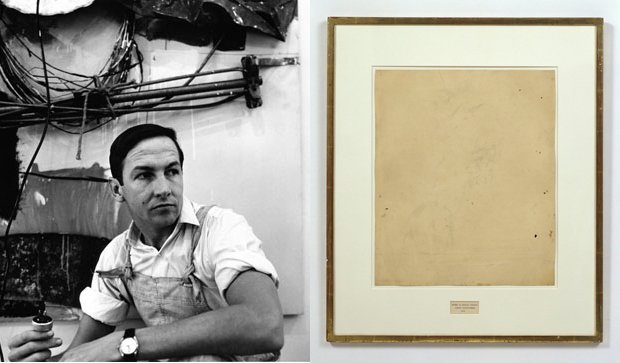
How Robert Rauschenberg erased a Willem de Kooning and created a landmark of postmodernism
Robert Rauschenberg was an important artist, whose multifarious works combined painting with sculpture, photography and performance. To understand him a little better, read this account, published in our Phaidon Focus edition dedicated to the artist, about one of Rauschenberg's most famous works, Erased de Kooning Drawing. Realised in 1953 with Willem de Kooning's consent, it was both a performative work and a collaborative one (Rauschenberg's good friend Jasper Johns even did the lettering, 'Erased de Kooning Drawing, Robert Rauschenberg, 1953'). The mount and the frame were important to the piece, as was the fact that it was actually a de Kooning that had been erased. Here's how the book describes it.
{media1}
"In the midst of an experimental period during which he made paintings from such materials as gold leaf, toilet paper and dirt, Rauschenberg asked himself whether a drawing might be made from erasing. At first, he tried erasing what he had drawn, but this was not satisfying, and he decided that he needed a drawing that was inarguably a work of art. He went to the painter Willem de Kooning, explained his project and asked him for a drawing to erase. Initially reluctant, de Kooning soon agreed, going through stacks of drawings to find one with a combination of media that would be difficult to erase. Several weeks and many erasers later, Rauschenberg had completed his task. The sheet of paper, with ghostly traces of the image remaining, was subsequently matted and framed with a small label that reads ‘Erased de Kooning Drawing – Robert Rauschenberg – 1953.’
"By selecting de Kooning, Rauschenberg chose perhaps the most prominent painter among the Abstract Expressionists, and his act would be widely interpreted as a symbolically patricidal gesture. Cage compared Rauschenberg’s erasure with L.H.O.O.Q., a work Duchamp made by drawing a moustache on a postcard of the Mona Lisa. Like Duchamp’s gesture, Rauschenberg’s Erased de Kooning Drawing has been hailed as a landmark of postmodernism because of its subversive appropriation of another artist’s work, and it has also been understood as a rejection of the traditional practice of drawing as the foundation of painting.
{media2}
"Yet Rauschenberg’s motivations and the resulting act were more complex than these interpretations suggest. To begin with, de Kooning’s cooperation was key: he consented to what he understood all too well might be construed as an act of aggression, and he took great care in his selection of the piece. Moreover, Rauschenberg admired his work tremendously and already owned two sketches by him. One was a doodle on a coaster de Kooning had left in a restaurant; Rauschenberg had scavenged the other out of the refuse during an earlier visit to his studio (de Kooning was out, and Rauschenberg also photographed his studio). In devising a project devoted to the role of erasure in drawing, Rauschenberg was in a sense paying tribute to de Kooning, whose habitual revision, erasure and assembling of painted and drawn elements were integral to a manner of painting that many others had begun to imitate. In fact, de Kooning’s proficiency in such processes rendered him a particularly good judge of what made a drawing difficult to erase.
"By erasing de Kooning’s drawing, Rauschenberg prepared for his own return to painting, and his act served as a way of confronting de Kooning’s influence. A peculiar and aggressive homage, it took de Kooning’s own methods to such extremes that it ended up eradicating its source: this was supreme irony. In the Red Paintings that followed, Rauschenberg used richly gestural brushwork identifiable with de Kooning’s approach to painting."
If you're intrigued by that short passage you can pre-order Robert Rauschenberg here. You may also care to check out the other books and artists in the Focus Series. Meanwhile for more on the artist erased, buy our magesterial Willem de Kooning monograph, here.